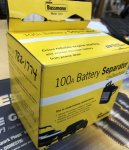*Original post in Modification thread.
Hi,
I apologize if questions like this has been asked before. But I didn’t really find something that seemed to best answer the particular situation I am working on in my own small set up and car.
I have a Subaru outback and some accessories that runoff of a deep cycle battery that I can either charge using a standard wall charger or an 80 W solar panel.
Obviously and 80 W solar panel is a little bit problematic as I live in Washington state.
And as we all know sun can be a little unreliable and the trees. However the 80 W panel is fully capable of running my 50 W fridge cooler, and still supplying a little bit extra for charging the battery; but it would take an eternity in that setting. Also, can’t really use the panels while driving.
I used my 400wt inverter to charge of the wall charger, but that didn’t work and I had a repair to make...
So I am trying to determine a good and safe way to set up a battery isolation system where I can safely charge the deep cycle battery in the back of my car, without putting any risk on either the alternator or car battery and/or intern the deep cycle.
When I call places like camping world and auto-parts stores they seem thoroughly confused with the concept of what I’m trying to do. I know it can’t be that unheard of, I’ve seen it done in RV and where others are showing off rigs, both custom and etc
Probably longer winded than it needed to be but I would appreciate any expertise that anybody might have. if you have a recommendation of product, that would help.
Hi,
I apologize if questions like this has been asked before. But I didn’t really find something that seemed to best answer the particular situation I am working on in my own small set up and car.
I have a Subaru outback and some accessories that runoff of a deep cycle battery that I can either charge using a standard wall charger or an 80 W solar panel.
Obviously and 80 W solar panel is a little bit problematic as I live in Washington state.
And as we all know sun can be a little unreliable and the trees. However the 80 W panel is fully capable of running my 50 W fridge cooler, and still supplying a little bit extra for charging the battery; but it would take an eternity in that setting. Also, can’t really use the panels while driving.
I used my 400wt inverter to charge of the wall charger, but that didn’t work and I had a repair to make...
So I am trying to determine a good and safe way to set up a battery isolation system where I can safely charge the deep cycle battery in the back of my car, without putting any risk on either the alternator or car battery and/or intern the deep cycle.
When I call places like camping world and auto-parts stores they seem thoroughly confused with the concept of what I’m trying to do. I know it can’t be that unheard of, I’ve seen it done in RV and where others are showing off rigs, both custom and etc
Probably longer winded than it needed to be but I would appreciate any expertise that anybody might have. if you have a recommendation of product, that would help.

